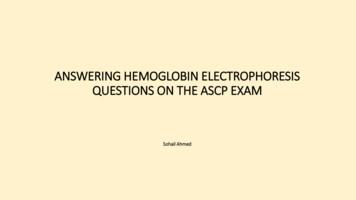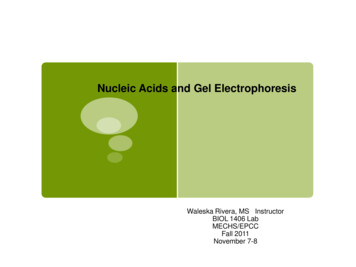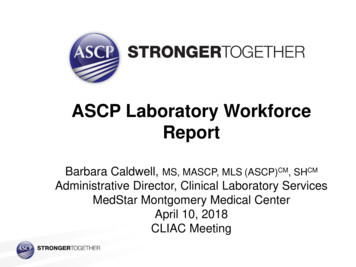
Transcription
ANSWERING HEMOGLOBIN ELECTROPHORESISQUESTIONS ON THE ASCP EXAMSohail Ahmed
Electrophoresis is a wonderful procedure used to separate anunknown into its constituent molecules.The distinctive pattern visualized (depending on the media),serves as a “fingerprint” of the unknown you are attempting toidentify.
Electrophoresis is used in both scientific research, and in daily testingThe concept is veryimportant and I urge youto read about it on yourownHOWEVER, we can forego anyextensive explanation here! Thefollowing slides contain the mostrelevant information you might wantto know for the ASCP exam.Take a look at the next slide. Don’t memorize it! Just look at it
NEXT SLIDES FORINTERPRETATION
Normally, 95% of our hemoglobin is Hgb A. That is why a person with normalhemoglobin will produce one fat band at the Hgb A position. Take a look at thediagram. Do you see the fat band at the Hgb A position in both instances?
Folks with sickle cell trait (AS) are heterozygous; they have one gene for Hgb A andone for Hgb S. Clearly, such a person ought to demonstrate equal sized bands at theA and S positions. Do you see that in both diagrams above?
Folks with sickle cell disease (SS) have two sickle cell genes, and will thus produce agreat deal of Hgb S. They will demonstrate one fat band at the S position. Thesefolks also demonstrate a very thin band at the Hgb F position. Can you see this inboth diagrams above?
Those with hemoglobin C disease (CC) have two genes for Hgb C. Thus, folks likethis would produce a great deal of Hgb C. Do you see that in both diagrams above?
Finally, folks with hemoglobin SC disease are heterozygous; they have one geneproducing Hgb S and one gene producing Hgb C. Such an individual willdemonstrate equal sized bands at the S and C positions. Take a look at the diagramsabove and confirm.
That was a lot of information. Here is what I would actually memorize:Whenever you come across a question dealing with hemoglobin electrophoresis,recall the above and you should be able to answer the question! We will try a fewquestions in the following slides.BEFORE YOU GO ON TO THE NEXT SLIDE, MAKE SURE YOU HAVEMEMORIZED THE NOTATION ABOVE!
QUESTIONS & ANSWERS
Question 1What do you suspect here?A)B)C)D)Patient with Sickle Cell Disease (SS)Patient with Hemoglobin SC Disease (SC)Patient with Hemoglobin C Disease (CC)Patient with normal hemoglobin
Answer 1D) Patient with normal hemoglobin Recall the picture you’ve memorized. The patient with sickle cell disease is in the second row. Based on that,we know where Hgb F and Hgb S are located. Also note the location of the anode ( ) and the cathode (-). Hgb F has separated out to a position adjacent tothe cathode. In the diagram you memorized, Hgb F is adjacent to the cathode when electrophoresis is run oncitrate agar (pH 6.2). The unknown in the last row is one large band which is located where Hgb A would be located at pH 6.2.Clearly, the unknown in the last row represents a patient with normal hemoglobin.
Question 2What do you suspect here?A)B)C)D)Patient with Sickle Cell Disease (SS)Patient with Hemoglobin SC Disease (SC)Patient with Hemoglobin C Disease (CC)Patient with normal hemoglobin
Answer 2C) Patient with Hemoglobin C Disease (CC) Recall the picture you’ve memorized. The patient with sickle cell disease is in the second row. Based on that,we know where Hgb F and Hgb S are located. Also note the location of the anode ( ) and the cathode (-). Hgb F has separated out to a position adjacent tothe cathode. In the diagram you memorized, Hgb F is adjacent to the cathode when electrophoresis is run oncitrate agar (pH 6.2). The unknown in the last row is one large band located adjacent to the anode ( ), which is where Hgb C wouldbe located at pH 6.2. The answer is C, a patient with Hemoglobin C Disease.
Question 3What do you suspect here?A)B)C)D)Patient with Sickle Cell Disease (SS)Patient with Hemoglobin SC Disease (SC)Patient with Hemoglobin C Disease (CC)Patient with normal hemoglobin
Answer 3B) Patient with Hemoglobin SC Disease (SC) Choices C & D are eliminated because they should demonstrate only one band and the unknown heredemonstrates two bands. Based on the pattern demonstrated by the known patient with sickle cell trait in the second row (two equalsized bands located adjacent to each other), we can determine that this electrophoresis is run on citrate agar(pH 6.2). We can’t be certain of the locations of the anode or cathode because this diagram could simply be flippedhorizontally. Then how can we decide between choices A and B? At pH 6.2, choice A would demonstrate twounequal sized bands located apart from each other. Choice B would demonstrate two equal sized bandslocated adjacent to each other on one extreme end of the medium. The answer is choice B, Hemoglobin SCDisease.
Question 4A 28 year old patient presents with mild, chronic anemia. This young man has consistently demonstrated a lowhemoglobin count for the 10 years he has been coming to this hospital for routine annual physicals. This hasnot proven to be a clinical problem but he is currently very concerned and his physician wishes to placate him.After ruling out other possibilities such as bleeding and poor nutrition, hemoglobin electrophoresis isperformed. Based on the patients result (patient result in “?” lane) what problem is suspected?A)B)C)D)Sickle Cell Disease (SS)Hemoglobin SC Disease (SC)Hemoglobin C Disease (CC)Sickle Cell Trait (AS)
Answer 4C) Hemoglobin C Disease (CC)We can easily eliminate choices A, B and D because the electrophoretic patterns associated with the diseasesmentioned in those answer choices do NOT match the pattern in the unknown lane. This information alone isenough to determine that the patient has Hemoglobin C Disease. Additionally, note that the patient is onlyproducing hemoglobin C. This is what you would expect with hemoglobin C disease.
Question 5In the United State, the National Collegiate Athletic Association (NCAA) recommends testing athletes forsusceptibility to sickle cell. A young athlete who demonstrates no symptoms is tested by means of hemoglobinelectrophoresis at pH 8.4, and the following pattern appears. What do you suspect?A)B)C)D)Sickle Cell Disease (SS)Hemoglobin SC Disease (SC)Normal patientSickle Cell Trait (AS)
Answer 5D) Sickle Cell Trait (AS)We know that this electrophoresis was performed at pH 8.4. Do you remember the diagram I asked you tomemorize? Did you draw the version used at pH 8.4?This is what electrophoresis looks like on the medium that is used at pH 8.4. Based on the control lane, youknow where C,S,F,A should appear on this medium. This patient clearly demonstrates production of Hgb A andHgb S. Thus, this patient has sickle cell trait (AS).
Question 6A 16 year old comes into the ER with intense pain. She describes her pain as very sharp and very intense. Sheappears very pale and hemoglobin testing confirms a low hemoglobin of only 6.0. Hemoglobin electrophoresisis performed at pH 8.4 and it reveals the following. What do you suspect?A) Normal hemoglobinB) Hemoglobin SC diseaseC) Sickle Cell DiseaseD) Sickle Cell Trait
Answer 6C) Sickle Cell DiseaseWe can rule out answer choice B because the patient’s pattern is different from the pattern seen withHemoglobin SC Disease, which is shown in the third lane. Since the question tells you that electrophoresis wasperformed at pH 8.4, draw out the pH 8.4 hemoglobin electrophoresis pattern that you should havememorized by now. The location of the bands in the third lane clues us in on the location of the anode andcathode. Recall the pattern! Remember that at pH 8.4, the cathode is closest to C & S. So now that we havedetermined the position of cathode (-), the anode ( ) and C and S, we are able to determine the positions ofHgb F and Hgb A. This patient demonstrates production of mostly Hgb S and a small amount of Hgb F. Whatdoes that describe? Coupled with the symptoms, we can be absolutely certain that the patient’s pattern pointsto Sickle Cell Disease.
to know for the ASCP exam. Take a look at the next slide. Don’t memorize it! Just look at it . NEXT SLIDES FOR INTERPRETATION. Normally, 95% of our hemoglobin is Hgb A. That is why a person with normal hemoglobin will produce one fat band at the Hgb A position. Take a look at the diagram. Do you see the fat band at the Hgb A position in both instances? Folks with sickle cell trait (AS) are .











